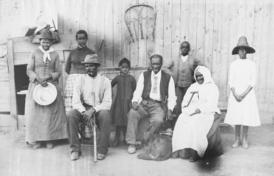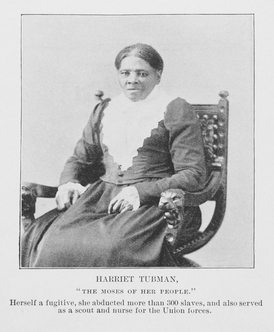Harriet Tubman
Harriet Tubman, or “Moses” as some called her, was worth $40,000 to anyone who could capture her and return her south. It was a huge reward, but southern slave owners figured that she had stolen property worth at least $300,000. What did she steal? Some 300 enslaved men, women, and children, taking them on the Underground Railroad to freedom.
Harriet Tubman was born around 1822, the property of a planter in Maryland. As a child she worked in his house but was soon sent out to do backbreaking fieldwork. After three of her sisters were sold, it was rumored that she might be sold to the cotton fields farther south, too. She knew she had to flee or she would never see her family again; in 1849 she made her escape alone. As a self-emancipated woman, Harriet Tubman then did what few others dared to do. She went back south—19 times, for her sisters, brothers, their children, friends, neighbors, and in one daring trip, her 70-year-old parents.
A master of disguises who knew how to find her way in the woods without leaving tracks, she outsmarted the slave catchers and their dogs every time. As she told Frederick Douglass, she “never lost a single passenger.” Her route took her through New York City, a “train depot” of the Underground Railroad. She and her passengers were hidden in local churches, homes, and offices and then sent on to Canada and freedom. Not even the Civil War stopped Harriet Tubman’s efforts. She joined the Union cause as a nurse and a spy. After the abolition of slavery, Tubman kept working for freedom, justice, and equality until she died in 1913.
This entry contributed by
Curriculum Concepts International
Related Media
Images

|
Harriet Tubman often stopped at the New York Anti-Slavery offices such as the one at 143 Nassau Street. There she and her passengers could get train or boat tickets to Canada and freedom.
|

|
Left to right: Harriet Tubman; Gertie Davis [Tubman's adopted daughter]; Nelson Davis [Tubman's husband]; Lee Cheney; "Pop" Alexander; Walter Green; Sarah Parker ["Blind Auntie" Parker] and Dora Stewart [granddaughter of Tubman's brother, John Stewart].
|

|
Harriet Tubman was one of the greatest conductors on the Underground Railroad. After emancipating herself, she returned south 19 times to help as many as 300 others gain their freedom.
|

